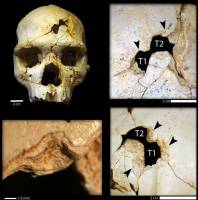09:10 Sima de los Huesos Hominin Skull Shows Evidence of Earliest Known Murder |
 Wounds identified on a 430,000-year-old hominin skull from the
archaeological site of Sima de los Huesos in northern Spain may indicate
one of the first cases of lethal violence in the hominin fossil record,
says a team of scientists headed by Dr Teresa Nohemi Sala Burgos of the
Centro Mixto UCM-ISCIII de Investigación sobre Evolución y
Comportamiento Humanos in Madrid. The Sima de los Huesos – the Pit of Bones – is a cave site in Atapuerca Mountains, northern Spain. Between 600,000 and 300,000 years ago, the region was inhabited by a population of a fossil hominin species, named the Sima de los Huesos hominin after the cave site. According to previous studies, the hominin was part of the Neanderthal lineage and shared a common ancestor with Denisovans, an ancient human species that lived in a vast range from Siberia to Southeast Asia at the same time as Neanderthals. The Sima de los Huesos has been excavated continuously since 1984. After thirty years, archaeologists have recovered nearly 7,000 human fossils corresponding to all skeletal regions of at least 28 individuals. This extraordinary collection includes 17 skulls, many of which are very complete. One of these skulls, named Cranium 17 (Cr-17), is a 430,000-year-old, nearly complete specimen composed of 52 bone fragments preserving the complete facial skeleton. It belonged to a young adult individual and shows two penetrating lesions on the frontal bone, above the left eye. Relying on modern forensic techniques, such as contour and trajectory analysis of the traumas, Dr Sala and her colleagues from the United States and Spain showed that both fractures were likely produced by two separate impacts by the same object, with slightly different trajectories around the time of the individual’s death. According to the team, the injuries are unlikely to be the result of an accidental fall down the vertical shaft. "It is possible the injuries in Cr-17 could have been produced either during the free-fall down the vertical shaft (the mode of entry of the hominin cadavers to the site) or inside the Sima de los Huesos chamber after the body arrived to the site,” the scientists wrote in a paper published in the journal PLoS ONE. "The few cases of perimortem fractures in the postcranial remains might be attributable to the corpse landing on a hard object (e.g. limestone block) at the bottom of the vertical shaft. However, in the case of Cr-17, the same object likely produced the two fractures. Thus, any scenario related to the free-fall would require the highly improbable occurrence of the same object striking the skull twice.” Rather, the type of fracture, their location, and that they appear to have been produced by two blows with the same object lead the scientists to interpret them as the result of an act of lethal interpersonal aggression – or what may constitute the earliest case of murder in human history. |
| Категория: Archaeology | Просмотров: 1316 | |
| Всего комментариев: 0 | |



